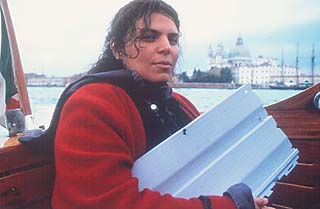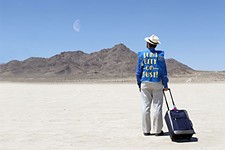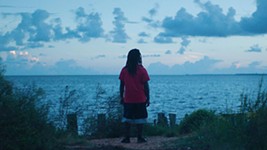First You Laugh, Then You Join Greenpeace
Filmmaker Judith Helfand finds toxic humor in her parents' back yard
By Anne S. Lewis, Fri., Nov. 8, 2002

Given filmmaker Judith Helfand's stock-in-trade -- her terrific personality and sense of humor -- she could probably rivet an audience to a documentary about the history of the stepladder. Not that Blue Vinyl's no-holds-barred look at the health and environmental damages wrought by the vinyl industry needed any help holding our interest. It didn't. It's just that Helfand's persona is the perfect foil for one of the larger points she makes in the film she co-directed with Daniel B. Gold and describes as a "toxic comedy": how daunting it can be for the wronged little guy to make a dent in -- or get heard by -- a multibillion-dollar industry that doesn't care because it doesn't have to.
Helfand had some serious firsthand experience in this business of toxic torts years before her parents decided to cover their Long Island house with vinyl siding: Her mother took DES (diethylstilbestrol) when she was pregnant with Helfand, and Helfand developed a rare form of cervical cancer, which required her to undergo a hysterectomy at the age of 26. That was the subject of her Peabody Award-winning 1997 film, A Healthy Baby Girl. In fact, the idea for Blue Vinyl occurred to Helfand when she was in Lake Charles, La., on the cross-country "toxic tour" she took the week A Healthy Baby Girl aired on the PBS series POV. She was using her DES story as a cautionary tale for the threat posed by dioxin, a byproduct of the Lake Charles plant's production of vinyl and polyvinyl chloride (PVC). While there, she learned for the first time about the health problems suffered both by PVC plant workers and those living near the emission-spewing facilities. Helfand recalls being "horrified to realize that my own family -- after all we had been through -- had unwittingly covered their house in vinyl, which meant that our purchase was connected to the health problems that these folks were suffering."
Lest you're hunkering down for a lugubrious, if eye-opening, juggernaut through the toxic mire that a heartless vinyl industry has wrought on the public that innocently took the bait, remember: This is a toxic comedy. With Gold behind the camera (the film took a cinematography prize at Sundance last year) and Helfand, our intrepid inquisitor, clutching a rectangle of blue vinyl from her parents' house to her chest, we laugh and cry through the vinyl enlightenment of the Helfand family, standing in, as they do, for Everyman, confronting the toxic realities of today's environment.
The prosecution's case seems pretty airtight, notwithstanding vinyl's undisputed usefulness as an affordable housing component. We learn of the health hazards to those who work in the PVC plants, or simply live in their environs, through the convincing testimony of scientists, an attorney who's made a career of taking on the PVC-makers, and victims, including former PVC plant workers in Venice, Italy, who sued the industry for cancers they subsequently developed. You've gotta laugh at the look on Helfand's face when, early on, she meets with Vinyl Institute representatives who dismiss her questions about PVC's safety with the usual bromides about chlorine's indispensability to the body; heck, it's as harmless as table salt. Later, Helfand will agree to the long list of silly conditions imposed upon a filmed interview with an industry scientist at a Baton Rouge hotel, and we're treated to the hilarious spectacle of a nervous Helfand, armed only with her shaky 10th-grade science education, being alternately stonewalled and pummeled with carefully scripted, essentially useless, scientific non-speak.
In the end, the conundrum for the Helfand family and their robin-egg-blue, vinyl-sided house boils down to this: Yes, they were unaware of the vinyl industry's dirty little secrets at the time they made the decision to apply the siding to their house, and, once installed, the only certain health and environmental hazard the siding poses at this stage of its life cycle would be triggered in the unlikely event of a house fire. So, do Ted and Florence Helfand have a moral obligation to undertake the considerable expense of removing their brand-new siding and replacing it with a material that is environmentally safe at each stage of its life cycle? See the film to learn how Ted and Florence's daughter convinces them -- on film -- to replace their vinyl with a responsible alternative and to learn how to resolve Everyman's dilemma of living the environmentally responsible life.
Austin Chronicle: It was pretty brave of you to center your film on your family's real-life vinyl-sided house and hope that you could bring them around to your point of view. What would you have done if they had refused to remove the vinyl?
Judith Helfand: Oh, that was simply not an option. They had to say yes. It was just a matter of when and how long it would take ... not if. Though I do remember when my mother got this huge grin on her face and said, "You know, you can do this virtually -- on a computer -- can't you? I know computers can do this these days." But thankfully -- though she was right -- I got her to see that it had to be the real thing. Then she started in on "But why my house?" My response was, because you're my mother, and I'm not connected to another house.
To get them to agree to the vinyl removal and replacement with a wood alternative, I had to prepare a formal proposal that explained every step of the process with promises as to the duration of the process -- it had to be done or at least presentable by the [Jewish] High Holidays; the yards had to be cleaned each day; there had to be a Porta Potti so the carpenters would not track mud into the house. And then, of course, we still had to find the replacement alternative -- which was not easy. It had to look more or less like the vinyl. The whole process was completely tenuous up until my mom finally agreed to use the reclaimed wood from the roof of an old mill in New Hampshire. With a huge sigh, she told me I'd finally worn her down. (I like to think that she came around and had an epiphany of sorts.)
The deal was that the reclaimed wood siding would be stained the same robin egg/pilgrim blue as the vinyl so if anyone drove past the house at a normal speed they wouldn't notice that anything was different. She didn't completely admit this but that was the case. It was harrowing, because Dan and Julia [Parker, co-producer] and Sari [Gilman, editor] were all counting on this to be the ending -- it had to be. But there was the reality of my mother's wrath ... so I had a lot of sleepless nights. My father became an advocate for taking the siding off way before my mom, and I would beg him to whisper to her at night while she was sleeping: "Florence, give them the vinyl; it's for a good cause." So the relief you see on my face onscreen when the vinyl is being removed is real.
AC: Your films are not made to be seen and then forgotten; they're more of a call to action with you leading the post-release charge. In fact, in addition to the Doc Tour screening, Blue Vinyl will be screened in an effort to convince the U.S. Green Building Council (which will be holding their annual meeting in Austin at the same time) to give green builder credit to those who eliminate vinyl from their products.
JH: When Blue Vinyl screened for packed audiences at Sundance, audiences were offered the opportunity to participate in a "direct action" to influence the PVC market by signing postcards to Intimate Brands, the parent company of Victoria's Secret and Bath and Body Works, encouraging them to use readily available alternatives to PVC packaging. By the end of our Sundance week, and 1,500 postcards later, Intimate Brands called Greenpeace -- who had initiated the activist fax and e-mail -- to discuss their PVC policy. Intimate Brands subsequently committed to 100% future phase-out of PVC packaging by 2003.
The film was made with the overarching goal of being entertaining -- while offering audiences the chance to observe their cynical acceptance of heedless corporate behavior and persistent chemical pollution and to reject it in favor of a solution, even if it is complicated and demands the participation of so many parties. Given that, you need to work with community and environmental health organizers from the get-go -- both to make sure the film is effective and to make sure that when the audience asks what can it do, there is a to-do list. And that is why we created a consumer-organizing and education project with the activists. It was launched at Sundance and will continue for the next two-plus years. It was designed by Working Films and is called My House is Your House (www.myhouseisyourhouse.org). The reason it works is because the movie is funny -- dangerous fun. ![]()
Blue Vinyl will be presented as part of the Texas Documentary Tour on Wednesday, Nov. 13, 8pm, at the Alamo Drafthouse North (2700 W. Anderson). Filmmaker Judith Helfand will introduce the film and conduct a Q&A session after the screening. Advance tickets are available online (www.austinfilm.org) for AFS members. Tickets will go on sale at 6:15pm on the day of the show. Admission prices are $6 per show for the general public, $4 for AFS members, JCAA members, KLRU members, and students. The Texas Documentary Tour is a co-presentation of the Austin Film Society, the University of Texas RTF Dept., The Austin Chronicle, KLRU-TV, the SXSW Film Festival, and the Hotel San José. For more on the International Green Building Conference, see "Naked City" in the News section or visit www.usgbc.org
.










